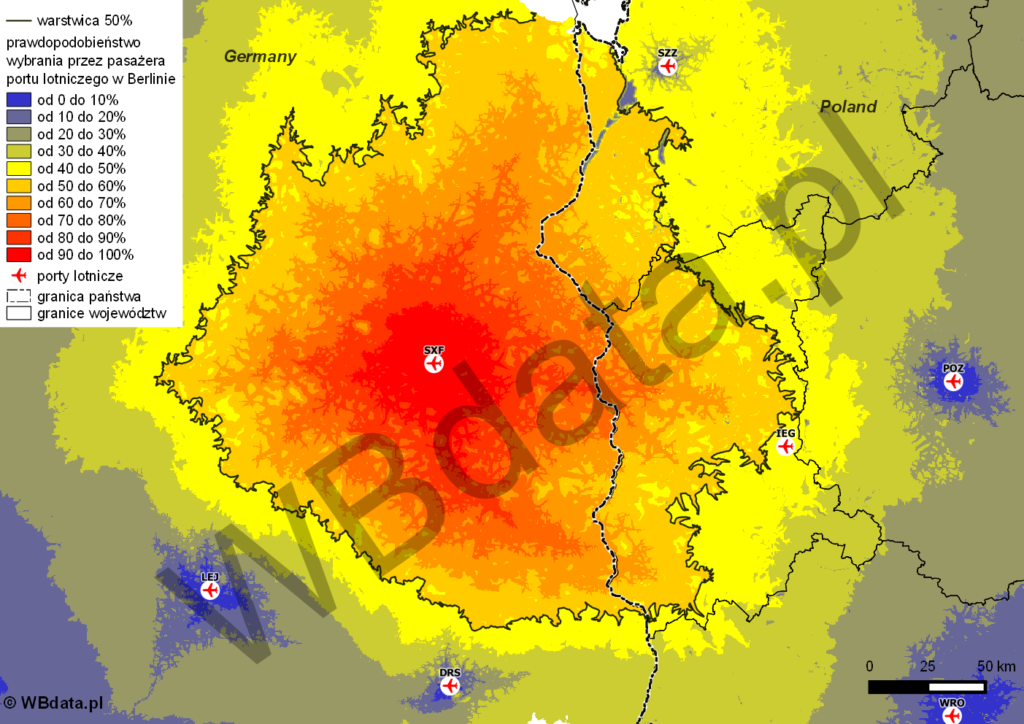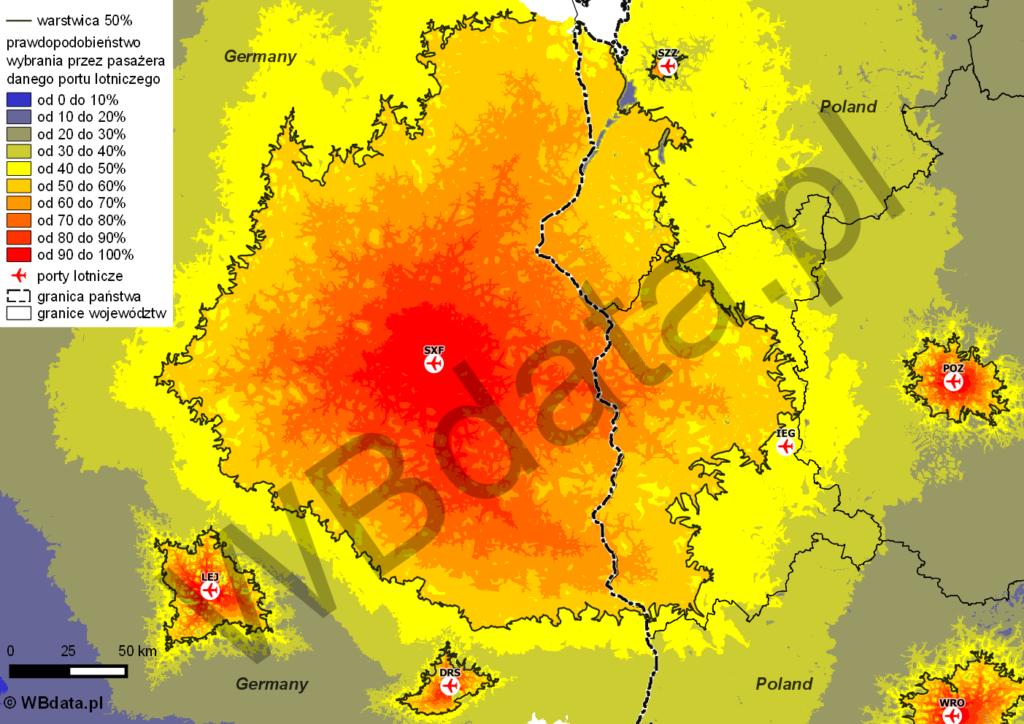[:pl]
Artykuł opisuje rzeczywisty zasięg oddziaływania portu lotniczego w Berlinie na terenie naszego kraju. Zasięg został obliczony za pomocą modelu Huff’a, który to model został opisany w poście Analiza konkurencji lotnisk. Miarą atrakcyjności lotniska jest wielkość przewozów pasażerskich w 2014 roku wszystkich polskich i niemieckich lotnisk, na których odbywa się ruch krajowy i międzynarodowy. Zbadano 22 niemieckie i 13 polskich lotnisk. Dla portu lotniczego w Berlinie wybrano lokalizację lotniska Schönefeld (SXF) i zsumowano liczbę pasażerów lotniska Schönefeld i Tegel. Wkrótce zostanie otwarte lotnisko Berlin Brandenburg im. Willy Brandta i będzie to główne lotnisko tej części Niemiec.
Po naszej ostatniej publikacji wspomnianej Analizy konkurencji lotnisk pojawiły się prośby, żeby obliczyć zasięg lotniska w Berlinie, Pragi i innych portów w pobliżu polskiej granicy. Prośbę spełniamy i przedstawiamy rzeczywisty zasięg oddziaływania portu lotniczego w Berlinie na terenie Polski.
Jak widać na mapie lotniska w Berlinie mają duży zasięg oddziaływania na terenie Niemiec. Na terenie naszego kraju zasięg strefy od 50 do 100% obejmuje dwa województwa, zachodnią część województwa zachodniopomorskiego i większą część województwa lubuskiego.W województwie zachodniopomorskim działa Port Lotniczy w Goleniowie, póki co ma jednak małą ofertę, a przez to atrakcyjność, by przyciągać większą liczbę pasażerów. Z kolei w województwie lubuskim działa Port Lotniczy w Babimoście, który obecnie ma jedno połączenie do Warszawy i jego atrakcyjność jest minimalna. Widać to doskonale na mapie, gdzie warstwica o 50% prawdopodobieństwie przebiega blisko lotniska w Babimoście.

Warstwica o pięćdziesięcioprocentowej wartości oznacza, że obszar wewnątrz tej warstwicy znajduje się w obszarze oddziaływania danego lotniska i jest duże prawdopodobieństwo, że mieszkańcy tego obszaru skorzystają z danego lotniska.
Druga mapa przedstawia rzeczywisty zasięg oddziaływania dla lotnisk otaczających Berlin, które mają dużo mniejszy zasięg oddziaływania, z uwagi na mniejszą atrakcyjność (mniej pasażerów w 2014 roku). Obszar o 40% prawdopodobieństwie wybrania lotniska w Berlinie otacza lotnika w Babimoście i Goleniowie. Zapewne mieszkańcy tych terenów poważnie biorą pod uwagę skorzystanie z lotniska w stolicy Niemiec z uwagi na dużą ofertę kierunków oraz w miarę bliską odległość.

Model Huff’a pozwala też obliczyć liczbę mieszkańców danej strefy prawdopodobieństwa oraz prawdopodobnych pasażerów, którzy skorzystają z oferty lotniska.
Na terenie województwa lubuskiego w strefie oddziaływania berlińskiego lotniska mieszka prawie 550 tys. osób, z tego 56,5% mieszkańców prawdopodobnie skorzysta z oferty tego lotniska. Natomiast ponad 55% mieszkańców województwa zachodniopomorskiego, czyli ponad 360 tys. osób prawdopodobnie skorzysta z niemieckiego lotniska.
Tutaj warto zaznaczyć, że założono, iż jedna osoba rocznie statystycznie odbywa jeden lot. W 2014 roku, wskaźnik mobilności oscylował w okolicy 0,65.
| województwo | liczba potencjalnych pasażerów | liczba mieszkańców | odsetek pasażerów |
| lubuskie | 310441 | 549398 | 56,51 |
| zachodniopomorskie | 366916 | 665177 | 55,16 |
Podsumowując Port Lotniczy w Berlinie ma duży potencjał, który wykorzystuje. Póki co, lotniska zachodniej Polski mają skromną ofertę kierunków. Do Berlina jest dobry dojazd z Polski, zarówno drogowy jak i kolejowy. Dużo przewoźników prywatnych oferuje transport bezpośrednio na lotnisko. Polskie lotniska z zachodniej części Polski muszą przeanalizować czy chcą walczyć o pasażera czy chcą uzupełniać ofertę lotniska w Berlinie.
[:en]The paper describes the actual impact range of Berlin airport in Poland. The range was calculated using the Huff model, which has been described in “Competitive Analysis of Airports”. The measure of airport attractiveness is the volume of passenger transport in 2014 of all Polish and German airports that handle the domestic and international traffic. 22 German airports and 13 Polish airports have been examined. For Berlin airport, the location of Schönefeld Airport (SXF) was selected and the number of passengers of Schönefeld and Tegel airports was totalled. Berlin Brandenburg Airport will be open shortly, which is intended as the main airport in that part of Germany.
Following our last publication of “Competitive Analysis of Airports”, we got requests to calculate the impact range of the airports in Berlin and Prague and other airports near the Polish border. We have decided to meet this request and therefore we would like to present the actual impact range of Berlin airport in Poland.
As you can see from the map, Berlin airports have a large impact range in Germany. In our country, the range of the zone from 50 to 100% covers two provinces, the western part of Zachodniopomorskie Province and the greater part of the Lubuskie Province. The Zachodniopomorskie Province has an operating airport in Goleniów, however, for now its offer is limited, and thus its attractiveness is not sufficient to attract more passengers. On the other hand, the Lubuskie Province has an airport in Babimost, which currently has one connection to Warsaw and therefore attracts very small number of passengers. You can see it perfectly on the map, where contour of 50% probability goes close to the airport in Babimost.

The contour of fifty percent means that the area inside the contour is located in the catchment area of the airport, and there is a high probability that the residents of the area will avail of that airport.
The second map shows the actual impact range of the airports around Berlin, which is much smaller because these airports are less attractive (smaller number of passengers in 2014). The area with 40% probability of selecting the airport in Berlin surrounds the airports in Babimost and Goleniów. The residents of these areas might seriously consider using the airport in Berlin as it has large offer of directions and is relatively close.

The Huff model also enables to calculate the number of inhabitants in a given probability zone and the passengers who are likely to avail of the airport’s offer.
In the Lubuskie Province, there are nearly 550 thousand people living in the impact zone of Berlin airports, of which 56.5% of the population is likely to avail of the airport’s offer. More than 55% inhabitants of Zachodniopomorskie Province, i.e. more than 360 thousand people are likely to use the German airport.
It is worth noting here that statistically one person per year takes a flight. In 2014, the mobility rate fluctuated around the value of 0.65.
| province | number of potential passengers | population | percentage of passengers |
| lubuskie | 310441 | 549398 | 56,51 |
| zachodniopomorskie | 366916 | 665177 | 55,16 |
To sum up, the airport in Berlin has a great potential, and benefits from it. Currently, the airports in western Poland have a small offer of directions. Berlin is easily accessible from Poland, both by road and rail. Many private carriers offer transport services directly to the airport. Polish airports in the western part of Poland have to consider whether they want to fight for passengers or complement the offer of Berlin airport.
[:]

